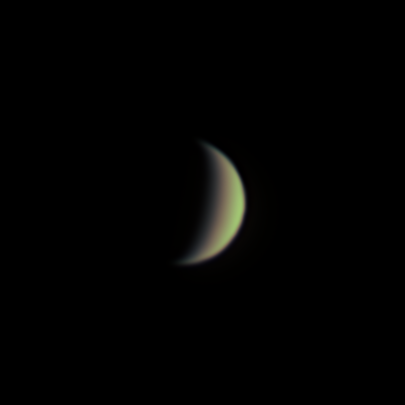This is my astrophotograph of Venus, taken on 19 April 2020 between 20:55 and 21:04 BST while it was 34% illuminated. The crescent has been beautifully captured but unfortunately without any details like clouds (I expect I need much better atmospheric conditions and more aperture than my 4″ refractor provides.)
This was a divergence from my usual interest of deep-sky astrophotography and not really suited to my equipment (f/7 102-mm refractor) or my skill set. Nevertheless, it was a good way to spend the forecasted 2-hr gap in the cloud and since I’d already had my usual optical assembly in pieces beforehand (to install a field flattener—another blog post to follow on this), I was ready to prepare another planetary optical assembly from the assorted spacers, adapters and other accessories.
I collected 1698× 1-ms frames and preprocessed them in PIPP to debayer, stabilise and estimate quality. Planets are strongly affected by the astronomical seeing (the turbulent mixing of the atmosphere that makes obects appear blurred, twinkling and moving around, just like viewing pebbles at the bottom of a stream). The very short exposure was partly to avoid blurring due to the seeing and also to avoid overexposing this very bright object. I exported the best 600 frames which are shown in the embedded YouTube video below (rotated 90° clockwise relative to the image above). This is often called ‘Lucky Imaging’ as it aims to capture the frames where the image distortion is least and discard the rest, although the video shows that even the best 600 frames were significantly affected by the poor seeing conditions. I stacked these best 600 frames in Autostakkert!, aligned RGB channels in Registax, and completed the final processing tweaks in Photoshop.
Venus, and the planets in general, appear as very small objects in comparison to most deep-sky objects. I therefore used a 3× Barlow lens to increase my focal length from 714 mm to an effective 2142 mm; and I used my Altair GPCAM3 290C planetary camera with its small sensor and small 2.9-micron pixels. Together, these gave me a pixel scale of 0.28 arcseconds per pixel, which is considered about right for planets. My telescope, with its 102-mm aperture, has a resolving power of 1.14 arcseconds (this is called Dawes’ limit). The Nyquist criterion says that more than 2 pixels are needed across features of this size to properly resolve them. My setup gives about 4 pixels so it appears to be correctly matched.
My optical assembly for planets with the 3× Barlow lens is quite long. As shown in the photograph below, to achieve focus and bring it down from an M68 thread at the camera end of the main telescope tube to the 1.25″ push-fit camera nosepiece, I need 2×50-mm extension tubes (M68), an M68 to 2″ adapter, a 50-mm extension tube (2″), a 2″ to 1.25″ adapter, a 3× Barlow, and a 20-mm extension tube around the camera nosepiece. It’s quite unweildy and I have to pay attention to avoid the tube crashing with the tripod legs. Like I said, this is not my usual setup.

Frames
- 1698× 1-ms light frames (600 best frames stacked)
- 51× dark frames
- No other calibration frames
Equipment
- Explore Scientific ED 102 mm Apo f/7 refractor
- Sky-Watcher EQ5 PRO SynScan GOTO equatorial mount
- Altair GPCAM3 290C colour camera (with UVIR window fitted)
- Celestron X-Cel LX 3× Barlow
Software
- Sharpcap
- PIPP (Planetary Imaging Preprocessor)
- AutoStakkert!
- Registax
- Photoshop


